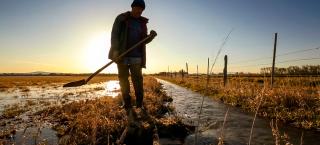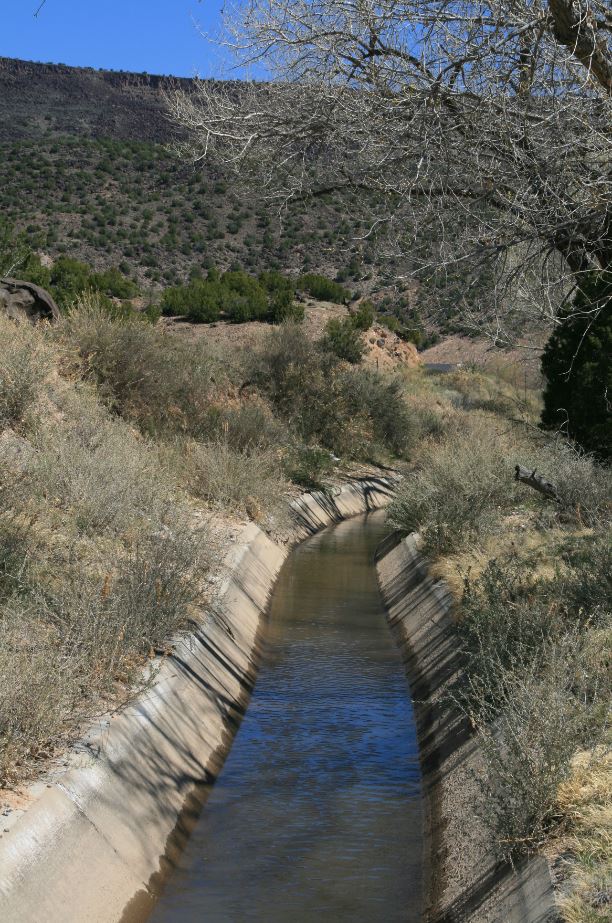
Story
Water, Democracy, and Sustainability: The Acequias of Southern Colorado
In a time of more frequent droughts and growing concerns about hydration, water rights, and resource conservation, some are starting to turn towards a centuries-old tradition of irrigation that still thrives in southern Colorado: the acequias.
Acequias are a unique method of water management, originating from Spain and North Africa. Under the acequia system, water is seen not as something that individuals can own but rather as a resource in place, shared by the community and distributed according to each landowner’s need.
An acequia is a communal irrigation canal, from which other, smaller ditches flow. Every farm in a community borders the mother acequia or one of its daughter streams, and is entitled to a certain portion (parciente) of the water; but in return, the farmers are expected to contribute to maintenance, upkeep, and repairs of the ditch. Every family or individual does their part, and as a result the entire community benefits.
While this method has become less common the world over with the advent of modern methods like circle crop irrigation, many of the farmers in the San Luis Valley of southern Colorado still maintain their ancestral acequias—and they firmly believe it’s not just better for their farms, but better for the environment.
“They have different kinds of irrigation which do damage to the aquifers,” said José Martinez, a farmer from San Francisco, Colorado, and former president of the San Francisco Acequia Council. “Our area is the only one that irrigates with a full, acequia-only system. It’s a system that’s very efficient—it cuts nearly in half the work you do, and it spreads the water a lot more evenly. It helps conserve a lot of water.”
José Martinez and his wife, Juanita, are natives of the San Luis Valley. José is a parciente of the San Francisco acequia, and both he and his wife are active members of the local council.
The San Francisco acequia, which provides water to the Martinez ranchito and their neighbors, is nearly two centuries old. It was likely first dug when the community of San Francisco was founded, as early as 1860. And there are acequias across the border in New Mexico that have been in use for even longer.
“Whenever I’m in my ranchito and I let the water go and irrigate, I have a lot of time to think,” said José. “And I say to myself it is amazing how the pioneers who started here were able to engineer these acequias in such a way that they could cover every property. It takes a lot of savvy, you have to look at the land and its contours. It’s totally mind blowing.”
The earliest settlers in Colorado came to the San Luis Valley from Nuevo México and other neighboring Mexican territories, and they brought with them their unique culture and traditions of land management, which were particularly well-suited to the dry climate of the valley.

La Canova acequia in northern New Mexico. While not a part of the same system as in southern Colorado, the New Mexico acequias come from the same tradition and history.
The acequias system of water management originated not in the Americas, but in the Old World. It was developed during the early Middle Ages in southern Spain and North Africa, when both were controlled by the Umayyad Caliphate. In both regions, water is a scarcity. As a result, farmers had to band together and share what little they had in order to ensure they could all survive and even thrive on otherwise barren land. The method that developed was communal and even democratic.
“It’s the most democratic process you’ll ever see,” said Juanita Martinez, who is one of the very first women to sit on an acequia council in the tradition’s long history. “We have farmers who are very wealthy with more than two hundred acres, and they have only one vote each. If we have ten acres, we have one vote. One man or woman, and one vote.”
The parcientes of the San Francisco acequia meet regularly to discuss maintenance to the canal, any changes that need to be made, and, of course, to decide the distribution of water for the season.
Upkeep of the acequia is handled by the community as a whole, with each farm paying dues based on acreage. The truly democratic system, said José and Juanita, ensures that each farmer pays a fair percentage of maintenance and that the acequia remains in good repair. After all, if the acequia is damaged, everybody in the community suffers as a result.
Both José and Juanita are very focused on the future of their community, and very conscious of sustainability both for their way of life and for the environment that supports it.
“The water is all one system,” said José, referring not just to his community but to the environment at large. “Without water, the land is worthless. We have to keep it sustainable, and that will benefit future generations. If they don’t, it will dry up. And that will affect us down here, and everywhere. The water is all one system.”

Maintenance of the acequia system is an intensive process, which requires everybody in the community to pitch in.
José and Juanita Martinez, and others in their community, believe that their methods of farming, including the acequia system, can provide examples of sustainable agriculture to other regions.
“Let it be as natural as possible,” said Juanita.
The acequia council has long been concerned about preventing damage to the water supply and to the environment in general. They have long prohibited the use of certain chemicals in farms served by the acequia, to prevent contamination of the aquifer.
“And as a result of that, we have gotten connections with people who want meats with no chemicals or have been fed organically,” said Juanita. “It’s more sustainable, and as natural as possible.”
Acequias are more widespread in New Mexico, where they have been protected and legislated by the state government since the early 1900s. In Colorado, legislation recognizing the acequia councils was only passed in 2012. But José and Juanita are hopeful.
They believe that the acequias are here to stay, and may in fact spread and grow as years go by.
“I believe it is spreading,” said José. “In New Mexico, and here.”
“The future of it is going to be okay, because of young people,” said Juanita. “Young people are becoming more conscious of the food they eat. The produce has to come from certain places. They want their beef and lamb and veggies to be organic, and clean.”
Sources
Peña, Devon G. “Cultural Landscapes and Biodiversity: The Ethnoecology of an Upper Río Grande Watershed Commons.” La Gente: Hispano History and Life in Colorado (Denver: History Colorado/Colorado Historical Society, 1999).
